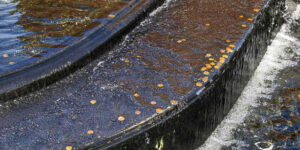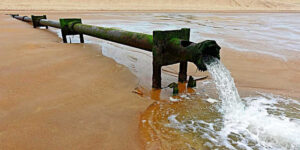Major Causes of Water Pollution: Water pollution is defined as the direct or indirect alteration of water properties resulting in the presence of physical, chemical, and biological components, or other factors producing a condition or impairment to a given water body. Water pollution is classified into surface water pollution and underground water pollution. Surface water pollution is the contamination of surface water bodies such as lakes, rivers, oceans, and dams, while underground water pollution is the pollution of underground water sources such as aquifers. Surface and underground water pollution can occur from point sources or non-point sources. Point sources of water pollution have a direct identifiable source of pollution whereas non-point sources of pollution are more diffuse are from different unidentifiable sources of water pollution.
10 Major Causes of Water Pollution
- Sewage and non-bio gradable solid wastes are examples of point source water pollutants. In the current world, the management of non-biodegradable solid waste is impaired due to the production of huge volumes of polymers and organic wastes generated daily. In developing countries and third world countries, an estimated 90 percent of sewage water is discharged directly into rivers and streams without any scientific treatment. In first world countries, untreated sewage, pseudoscientifically treated sewage, or overflow from under-capacity sewage handling facilities can send disease-bearing water into oceans and rivers. Leaking septic tanks and infiltration of sewage water can cause groundwater and stream contamination. Moreover, some Sewage components constitute nitrogen and phosphorus components that have a fertilizing effect on water sources, causing the algal bloom effect and eutrophication on water sources thereby reducing dissolved oxygen content in the water leading to aquatic death.
- The main cause of surface water pollution in oceans and high seas is uncontrolled oil spillage. The Deepwater Horizon oil spill is considered the largest marine oil spill in the history of the petroleum industry. It occurred in the Gulf of Mexico, which lead to spillage of 210 million gallons of oil that covered approximately 0.78Km3 that lead to the death of thousands of aquatic life as a result of water pollution. Uncontrolled oil spillages and oil discharges from cargo tankers carrying crude oil, diesel, or petroleum are considered among the largest environmental disasters affecting water purity. Also, offshore oil exploration leads to water pollution. The residual oil spreads over the water surface forming a thin layer of water-in-oil emulsion that is hazardous to human and aquatic life.
- Agro-chemical Wastes are the leading nonpoint sources of water pollution. Agro-chemical wastes majorly include pesticides and fertilizers. Pseudoscientific disposal of pesticides from field farms and agricultural activities contributes a lot of pollutants to water bodies and soils. Poorly disposed fertilizers and pesticides reach water bodies through surface runoff from agricultural fields, a massive spraying of pesticides and fertilizers, washing down of agro-chemicals by precipitation that jeopardizes the water quality. Most of them are non-biodegradable and persistent in the environment for a long period. Agro-chemicals have chemical components such as phosphates and nitrates that have a fertilizing effect on water bodies causing eutrophication. As a result of eutrophication, caused by the disposal of pseudoscientific agrochemicals into water bodies, water hyacinth has become a major invasive plant species in lakes such as Lake Victoria that is a leading water pollutant in lakes. These are the major causes of water pollution.
- Biological pollution is a major point source water pollutant. In oceans and seas, biologically or accidentally introduced alien species into water bodies are a major problem. Alien species or invasive species are foreign animals or plants that have been introduced into a different ecosystem away from their natural habitat. Outside their normal habitat, they have no natural preys and predators, these trigger an upset in the ecosystem, inhibiting the thriving of usual animals or plants that thrive there. Examples of an invasive species are the zebra mussels in the Great Lakes of the USA, which were carried from Europe by ballast water. As an impact of invasive species in their unnatural habitat, an alien jellyfish called Mnemiopsis leidyi reduced fish stocks by 90 percent after arriving in the ballast water of In the Black Sea.
- Global warming as a result of climate change has also led to water pollution. Global warming has an impact on water resources through enhanced evaporation, geographical changes in precipitation intensity, duration and frequency of soil moisture, and the frequency and severity of droughts and floods. Global warming as a result of climate change results in heavy intense downpours, droughts, and rising temperatures. Due to increased temperatures, there is increased evaporation which lowers the water pH altering water purity. Some Bacteria and Viruses thrive well in these new conditions favoring water pollution. These are the major causes of water pollution.
- Pseudoscientific, disposal of radioactive waste is hazardous to water ecosystems and human health. Radioactive waste in high concentrations can kill whereas in lower concentrations it can cause cancerous illnesses. The largest sources of water pollution from radioactive wastes in Europe are two factories that reprocess waste fuel from nuclear power plants; Cap La Hague on the north coast of France and Sellafield on the north-west coast of Britain. Nuclear plants discharge radioactive wastewater into the water bodies, which are widespread by the ocean. Norway, which lies downstream from Britain, receives significant doses of radioactive pollution from nuclear plants, and a significant volume of water pollution. These are the major causes of water pollution.
- Industrial waste is a leading point source water pollutant. Many of the industries require water as a key raw material hence they are situated along the river banks such as steel and paper industries. After manufacturing, their wastes containing acids, alkalis, dyes, and other chemicals are dumped and poured down into rivers as effluents. Industries that require chemicals as a raw material contribute the most to water pollution, for example, industries concerning with manufacture of aluminum and other heavy metals, release significant amounts of fluoride as effluents to water bodies, whereas agrochemical industries generate a huge amount of ammonia which are emitted into water sources as effluents. All such discharges finally arrive at water bodies cause a significant volume of pollution.
- Disruption of sediments during the construction of dams and water reservoirs leads to water pollution. Construction of dams and projects in and near river courses, for hydroelectric power or water reservoirs, can reduce sediment flow to rivers thus increasing erosion along the coast, where the eroded materials are deposited into water sources causing pollution. Besides, during construction work, soil, rock, and other deposits cause river water to be turbid making the water muddy and unsafe for consumption.
- Excessive emission of sulfur dioxide and nitrogen dioxide from natural and man-made resources yields acidic rain. Volcanic activities yield sulfurous and nitrous gases into the atmosphere that blend with atmospheric components such as hydrogen and oxygen to form acidic rains. The acid gases in form of precipitation through mist, snow, or rainwater flows into waterways that carry their acidic compounds into water bodies. The acid rain percolates in an aquatic environment, lowering water pH levels, negatively affecting aquatic biota. These are the major causes of water pollution.
- Chemical wastes are relatively toxic water pollutants. In detergents and bleaching, foams are highly toxic chemicals such as polychlorinated biphenyls. Heavy metals such as cadmium, mercury, and lead yield toxic pollution into the environment and water sources. Also, a highly toxic chemical called tributyltin is used in paints to protect boats from the corrosive effects of the oceans. However, corrosion of tributyltin on boat paints, its toxic components are shed into the ocean, causing water pollution.
In conclusion, there are many major causes sources of water pollution, both man-made and natural courses, with adverse impacts on water purity. Therefore, Human sources of water pollution should be minimized, and protective measures should be put in place to control water pollution.
These are the major causes of water pollution.
References.
- Green chemistry- James Noblet.
- Environmental pollution and control- Jeffery Pierce.
- Science Direct.
- Water pollution- P. Aarne Vesilind.
- Water- Wikipedia.
- Water pollution- research gate.
- Deepwater horizon- Wikipedia.








Pingback: Effects of Water Pollution on Human Health. - nPolluted
Pingback: The Impact of Water Pollution on Personal Finance (you have to experience it yourself) - nPolluted